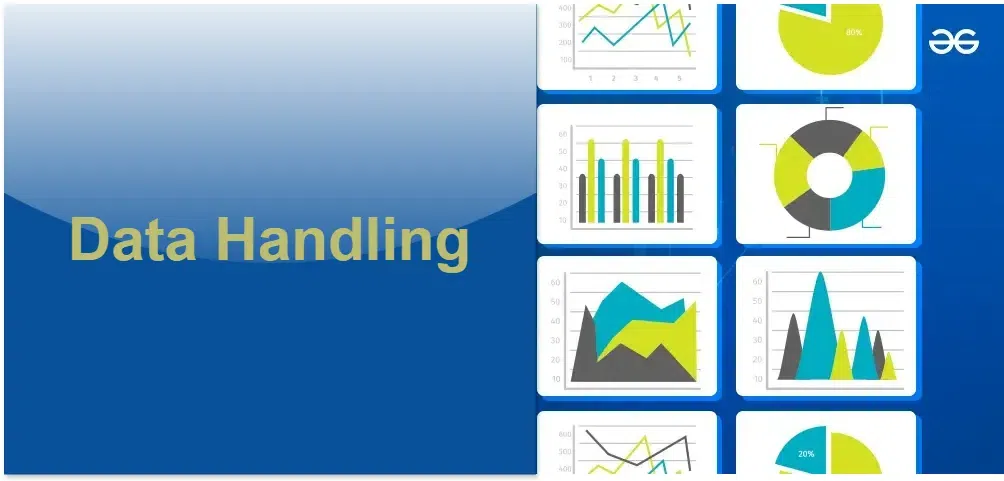
Data handling is crucial in real life in fields like business operations, healthcare, finance, education, and more. For instance, in healthcare, statisticians play a significant role in pharmacology, public health, and epidemiology, aiding drug discovery, community health education, and health data monitoring. Similarly, in finance, statistics guide financial policy decisions, risk assessment in lending operations, and market analysis, enabling individuals and organizations to make sound financial choices.

In this article we have covered definition of data handling, characteristics of data handling, applications of data handling and others in detail.
Data handling is the process of gathering, organizing, storing, and working with information to find valuable insights. It involves tasks such as collecting, checking, cleaning, analyzing, and presenting data.
Data handling is essential in various fields, including business, science, healthcare, education, and more, where large volumes of data are generated and need to be effectively managed to make informed decisions or draw conclusions.
Characteristics of data handling include:
Data handling is crucial in various real-life applications, including business operations, healthcare, finance, education, etc.
Data handling is essential in business operations to make informed decisions, solve problems, and understand trends. For instance, a company may collect sales, inventory, and customer feedback data to analyze trends and make informed decisions about production and marketing strategies. For example, a company may use a bar graph to represent sales data for different products over a month, helping them identify the most popular products and adjust production accordingly.
Data handling is crucial for monitoring and improving patient health outcomes in healthcare. For instance, healthcare professionals may collect data on patient symptoms, medical history, and test results to diagnose and treat medical conditions. They may also use data to monitor patient health trends and identify potential health risks. For example, a doctor may use a line graph to represent a patient’s blood pressure over time, helping them identify potential health risks and adjust treatment plans accordingly.
Data handling is essential in finance for making informed investment, lending, and risk management decisions. For instance, financial analysts may collect data on market trends, economic indicators, and financial statements to make informed decisions about investments and lending. They may also use data to monitor financial trends and identify potential risks. For example, a financial analyst may use a pie chart to represent the distribution of a company’s expenses, helping them identify potential cost savings and adjust budgets accordingly.
Data handling is essential in education for making informed decisions about teaching methods, curriculum, and student performance. For example, teachers may collect student performance, attendance, and engagement data to identify potential learning gaps and adjust teaching methods accordingly. They may also use data to monitor student progress and identify possible areas for improvement. Another example is that a teacher may use a histogram to represent student scores on a test, helping them identify potential areas for improvement and adjust teaching methods accordingly.
Data handling is essential in research for making informed decisions about research design, data collection, and analysis. For instance, researchers may collect data on various variables to test hypotheses and make informed decisions about research findings. They may also use data to identify trends and make informed decisions about future research. For example, a researcher may use a scatter plot to represent the relationship between two variables, helping them identify potential trends and adjust research methods accordingly.
Hence, it is evident that, data handling plays a crucial role in various aspects of modern society, driving decision-making, innovation, and progress across diverse fields. Data handling help us to take appropriate decisions based on the given set of data and help to maximize the use of available resource.
Data handling is the process of gathering, recording, and presenting information in a way that helps with analysis, predictions, and choices. It involves collecting data, maintaining security, and preserving research data.
Data can be represented graphically using various types of graphs, such as bar graphs, scatter plots, line graphs, area plots, pie charts/circle charts, picture graphs, and dot plots. The choice of graph depends on the purpose and the data type being represented.
Data handling is essential for making informed decisions, solving problems, and understanding trends in various real-life situations, from business operations to healthcare.
The steps involved in data handling are collecting raw data, organizing it in a systematic manner, analyzing it to extract insights, and presenting it in a clear and concise format.
Data handling is used in business operations to collect, organize, and maintain data to remain reliable and actionable. It is essential for making informed decisions, improving performance, and understanding trends.